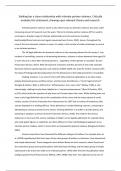Stalking has a close relationship with intimate partner violence. Critically
evaluate this statement, drawing upon relevant theory and research.
Intimate partner violence, which is also often known as domestic violence, has been under
increasing amount of research over the years. The term intimate partner violence (IPV) is used to
encompass a broader range of intimate relationships and circumstances including
boyfriend/girlfriend role sets and regular sexual partners (Corvo, 2019). Hence, throughout this
essay if the term domestic violence is used, it is solely in the context of violence between a current
or ex-intimate partners.
The UK legal definition for domestic violence in the meaning relevant for this essay is “any
incident of controlling, coercive or threatening behaviour, violence or abuse between those aged 16
or over who are or have been intimate partners… regardless of their gender or sexuality” (Crown
Prosecution Service, 2017). With 53.9 percent of women and 48.2 percent of men who reported
domestic violence reported partner-only violence (CSEW, 2019), the need for further research with
the hope of finding potential explanations for the behaviours to find solid prevention is invaluable.
Stalking, however, is an area of crime with little empirical explanation as to what makes
people obsessively pursue another person, and has been described as a “recent legal construct”
(Douglas & Dutton, 2001, p.519) and an “old behaviour, but a new crime” (Meloy, 1998, p. xix).
Interestingly, stalking has also been labelled as a “common phenomenon” (Buss & Duntley, 2011,
p.413), which posits the question of why more isn’t known about the crime. While stalking does not
have a strict legal definition due to the complexities of the crime and the many aspects it could
involve, section 2A of the Protection from Harassment Act 1997 lists a number of behaviours that
may be displayed in a stalking offence. These behaviours include following a person, contacting or
attempting to contact a person by any means, loitering (whether in a public or private place), and
watching or spying on a person (Crown Prosecution Service, 2018). The need for the various
behaviours is to ensure the various subtypes of stalker can be legally addressed, for example those
who stalk public figures or celebrities are often different in their methodological approach to ex-
intimate partner stalkers, which is more often accompanied by physical violence (Douglas & Dutton,
2001).
Various researchers have theorised the different subtypes of stalkers, for example Zona et
al. (1993) hypothesised that there were three main groups of stalkers: erotomanic, love obsessional,
and simple obsessional. These categories were defined based on their research, where they found
the erotomanic group to be purely stalkers with delusional thinking, and the latter group of simple
obsessional to be those who stalk an ex-intimate partner. While after the time of publication these
subtypes gained much literary favour (Meloy, 1997, 1998), they were not subjected to any sort of
, formal testing, nor were any actual stalkers assessed using the framework. In addition to this, there
is little information as to how the groups were formed or clear criteria for each, but were simply
based upon clinically informed speculation (Douglas & Dutton, 2001). Following from this, Meloy
(1998) hypothesised a similar set of stalker groups using victim-based research. From this, the three
groups were: intimates, strangers and acquaintances, which provides a useful conceptual basis in
terms of distinguishing between those who stalk ex-intimate partners and those who stalk others.
These are the three subtypes that will be used when discussing stalking throughout this essay.
The Crime Survey of England and Wales (CSEW) estimated that in the year ending March
2019, anywhere between 838 and 1,065 women and between 422 and 610 men were victims of
stalking. While the estimate is higher for females than males, it is still alarmingly high across the
board, particularly when the non-reported crimes are considered which typically applies to men
more than women (reference). The topic of gender roles will be discussed in more detail later.
The relationship between stalking and IPV have only began to become apparent through
deliberate empirical research in the past two decades, with much of this research coming under
scrutiny for methodological flaws such a sampling selection, along with issues of validity. Various
researches have attempted to confirm and dismiss theories of how the two crimes are or are not
similar through investigating both perpetrators and victims in a variety of settings including
community, forensic and psychiatric.
This essay will focus on two predominant theories in particular that have been used to
provide explanations for both the criminogenic and victimogenic variables of stalking and intimate
partner violence. Firstly the attribution of attachment theory will be critically examined in how it can
be used to explain and predict stalking and IPV, as well as any key similarities the theory presents
which could be useful for further research. Following this Social Learning Theory (SLT) will be
evaluated in terms of how both perpetrators and victims can be explained and predicted by the
theory for both crimes. This essay will also present any key recommendations that would be useful
for future research to expand the knowledge of both stalking and IPV with particular note to the role
gender norms play in terms of perpetrator and victim labelling by society, and how they may be
linked through theory.
Attachment Theory
This section will discuss how attachment theory can be used to provide explanation for
stalking and IPV, along with any issues this presents. Attachment theory is generally defined as the
relationship an infant has with their primary caregiver (often the mother), thus a strong attachment
is an affectionate, positive bond that sees the infant’s needs are met, which then is transferred to




